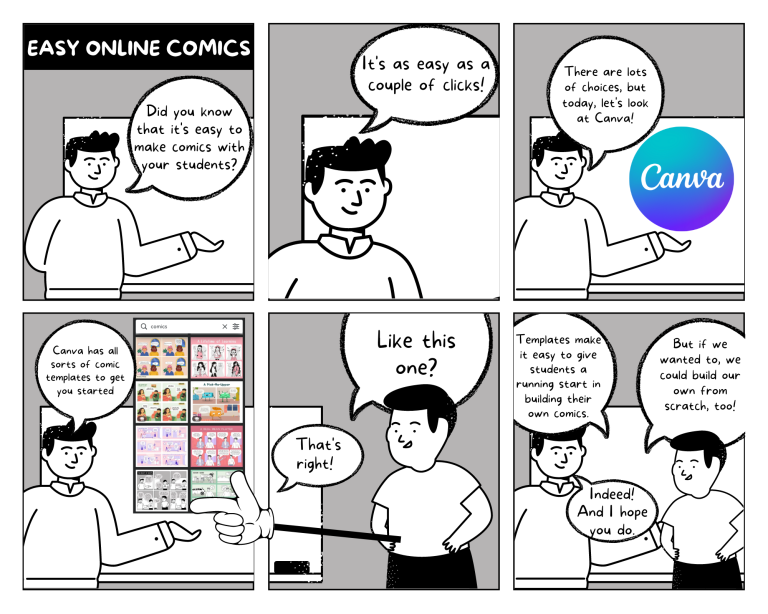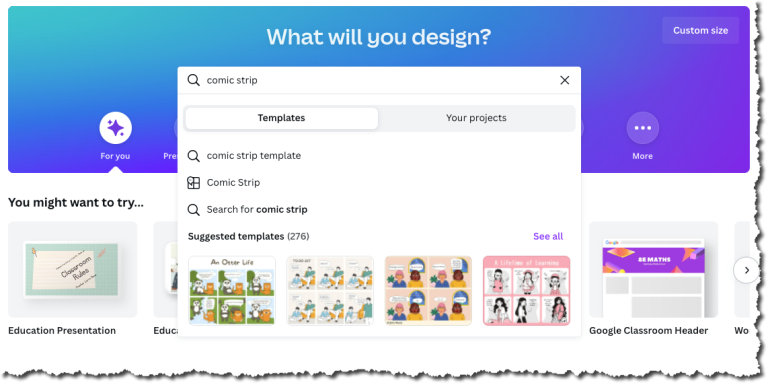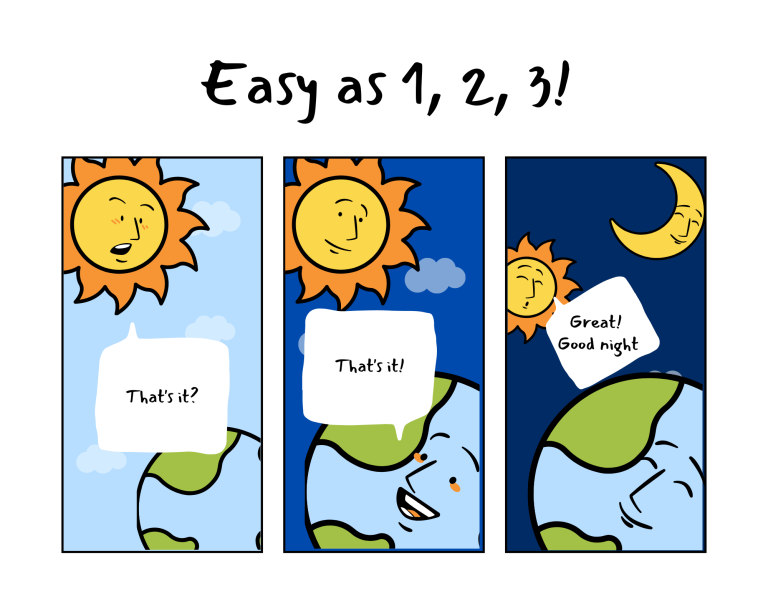Easy Online Comics for ELT
Over the last decade or so, comics and graphic novels have moved from what many considered disengaged distractions to great ways to encourage literacy in the classroom. In fact, there are teachers out there using comics as the core of their curricula, keeping students invested in their learning through storytelling all year long. But this is no secret to language teachers. As long as we’ve been able to give students a pencil and fold a piece of paper into six (or four, or eight) panels, we’ve encouraged our students to make up stories, build dialogue, and practice more English.
Still, many students hesitate to engage with drawing because they believe that they’re not artistic. While we can encourage them to show that some of the most popular comics out there, like XKCD or Strange Planet, are simply drawn, we can also use online services like Canva or Adobe Express to copy and paste some fast and easy comics together without much preparation.
Creating a Basic Comic

We’ll use Canva as an example because it’s free for teachers and students.
When you log in and type “Comic Strip” into the search bar, Canva will provide users with a large selection of suggested templates (276 at the time of publication) that you can use to start your students making their own comics.

To start, I recommend choosing something simple. In the gif here, you can see a simple three-panel comic. It provides a sample comic, a blank template, and a few icons, faces, and speech bubbles to work with. When you open the template, it will bring multiple pages for you to pick and choose artifacts from.
A basic scaffolding like this can make it easy for students at any level to feel comfortable. For those who may not feel as comfortable with technology, or for those who are just starting to build their language skills, a great way to get going is just to double click the text on the sample page and change the words to their own ideas. As students get a little more comfortable, they may choose to change the face on the sun, play around with colors, or even add more panels into their comic.

Example of how I remixed the comic template here. This took me only a few minutes, and most of that was because I was having fun playing with the colors of the sky.
Design platforms like Canva are very intuitive, so even without a background in art or design, teachers and students will find it easy (and fun!) to play around with. As learners play with it more, they will feel emboldened to change, shapes, and sizes at the same time as they work on fine-tuning their English to communicate their message.
Tips and Tricks
If you’re looking at the easy options here and starting to think, “Hey, maybe I can do this with my students,” you absolutely can! Here are a few tips to help get you started:
Practice First
Give yourself an hour or two to play around with Canva first. You don’t need to be a pro to introduce it to your students, but recognizing a few of the more common functions, like rotating images, cropping, and changing colors are things your students will probably ask you about. There are lots of tutorials to help you out. (Bonus: Share the same link with your students to save yourself time!)
Start Simple
As I mentioned, choose a starting template that doesn’t overwhelm. Templates that have too many characters, long dialogues, or detailed art may intimidate learners before they get started. One or two characters on a plain background is a great way for students to dip their toes in. It won’t take long until they want to expand on their own.
Pair Work
One of my favorite meta-level teaching tricks is to pair students together as they learn a new technology. If possible, pair someone who is a little more techy with someone who is a little less so. The techy student should be in charge of teaching their classmate, but keep the mouse firmly in the hand of the less techy student. This allows both students to practice clear communication in English without really being aware of what they’re doing.
Humor Your Students
Comics and jokes go hand-in-hand, but we know that not all jokes make it successfully across the language bridge. Instead of discouraging a student because a joke falls flat, consider running lessons around humor. While we all know that explaining humor can take the fun out of the joke, there are other ways to enjoy comedy, including getting a better understanding of what makes people from different parts of the world laugh.

Get Published!
No matter how deep we dig into the digital age, there’s still nothing like seeing your creation on the printed page. When you’re done with your lesson or unit, print out the comics that your students made. You can put them all together in a foldable booklet, and you can even ask your students to sign their work. I’ve included a sample cover that you can remix to your own needs, should you decide you’re going full-speed ahead.
A remix of a comic book cover template. Bonus: use filters on photos to add a “drawn” look to your pictures
Have you tried making comics with your students? What platforms did you use? There’s a huge world of choices out there, and even more ways to make comics work in the classroom. I hope you’ll share your own approaches with us in the comments below!

